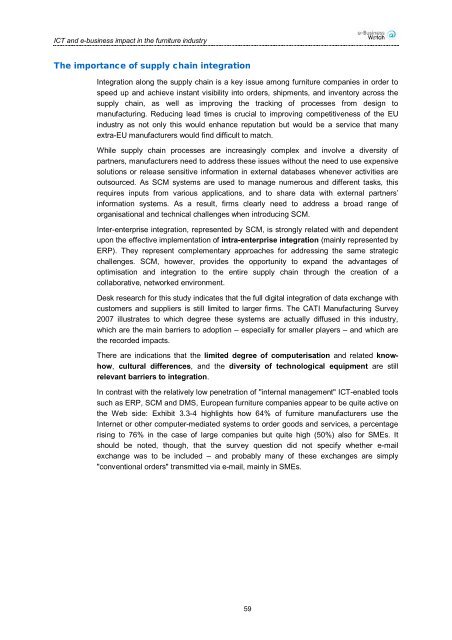ICT and e-Business Impact in the Furniture Industry - empirica
ICT and e-Business Impact in the Furniture Industry - empirica
ICT and e-Business Impact in the Furniture Industry - empirica
- No tags were found...
You also want an ePaper? Increase the reach of your titles
YUMPU automatically turns print PDFs into web optimized ePapers that Google loves.
<strong>ICT</strong> <strong>and</strong> e-bus<strong>in</strong>ess impact <strong>in</strong> <strong>the</strong> furniture <strong>in</strong>dustryThe importance of supply cha<strong>in</strong> <strong>in</strong>tegrationIntegration along <strong>the</strong> supply cha<strong>in</strong> is a key issue among furniture companies <strong>in</strong> order tospeed up <strong>and</strong> achieve <strong>in</strong>stant visibility <strong>in</strong>to orders, shipments, <strong>and</strong> <strong>in</strong>ventory across <strong>the</strong>supply cha<strong>in</strong>, as well as improv<strong>in</strong>g <strong>the</strong> track<strong>in</strong>g of processes from design tomanufactur<strong>in</strong>g. Reduc<strong>in</strong>g lead times is crucial to improv<strong>in</strong>g competitiveness of <strong>the</strong> EU<strong>in</strong>dustry as not only this would enhance reputation but would be a service that manyextra-EU manufacturers would f<strong>in</strong>d difficult to match.While supply cha<strong>in</strong> processes are <strong>in</strong>creas<strong>in</strong>gly complex <strong>and</strong> <strong>in</strong>volve a diversity ofpartners, manufacturers need to address <strong>the</strong>se issues without <strong>the</strong> need to use expensivesolutions or release sensitive <strong>in</strong>formation <strong>in</strong> external databases whenever activities areoutsourced. As SCM systems are used to manage numerous <strong>and</strong> different tasks, thisrequires <strong>in</strong>puts from various applications, <strong>and</strong> to share data with external partners’<strong>in</strong>formation systems. As a result, firms clearly need to address a broad range oforganisational <strong>and</strong> technical challenges when <strong>in</strong>troduc<strong>in</strong>g SCM.Inter-enterprise <strong>in</strong>tegration, represented by SCM, is strongly related with <strong>and</strong> dependentupon <strong>the</strong> effective implementation of <strong>in</strong>tra-enterprise <strong>in</strong>tegration (ma<strong>in</strong>ly represented byERP). They represent complementary approaches for address<strong>in</strong>g <strong>the</strong> same strategicchallenges. SCM, however, provides <strong>the</strong> opportunity to exp<strong>and</strong> <strong>the</strong> advantages ofoptimisation <strong>and</strong> <strong>in</strong>tegration to <strong>the</strong> entire supply cha<strong>in</strong> through <strong>the</strong> creation of acollaborative, networked environment.Desk research for this study <strong>in</strong>dicates that <strong>the</strong> full digital <strong>in</strong>tegration of data exchange withcustomers <strong>and</strong> suppliers is still limited to larger firms. The CATI Manufactur<strong>in</strong>g Survey2007 illustrates to which degree <strong>the</strong>se systems are actually diffused <strong>in</strong> this <strong>in</strong>dustry,which are <strong>the</strong> ma<strong>in</strong> barriers to adoption – especially for smaller players – <strong>and</strong> which are<strong>the</strong> recorded impacts.There are <strong>in</strong>dications that <strong>the</strong> limited degree of computerisation <strong>and</strong> related knowhow,cultural differences, <strong>and</strong> <strong>the</strong> diversity of technological equipment are stillrelevant barriers to <strong>in</strong>tegration.In contrast with <strong>the</strong> relatively low penetration of "<strong>in</strong>ternal management" <strong>ICT</strong>-enabled toolssuch as ERP, SCM <strong>and</strong> DMS, European furniture companies appear to be quite active on<strong>the</strong> Web side: Exhibit 3.3-4 highlights how 64% of furniture manufacturers use <strong>the</strong>Internet or o<strong>the</strong>r computer-mediated systems to order goods <strong>and</strong> services, a percentageris<strong>in</strong>g to 76% <strong>in</strong> <strong>the</strong> case of large companies but quite high (50%) also for SMEs. Itshould be noted, though, that <strong>the</strong> survey question did not specify whe<strong>the</strong>r e-mailexchange was to be <strong>in</strong>cluded – <strong>and</strong> probably many of <strong>the</strong>se exchanges are simply"conventional orders" transmitted via e-mail, ma<strong>in</strong>ly <strong>in</strong> SMEs.59
















